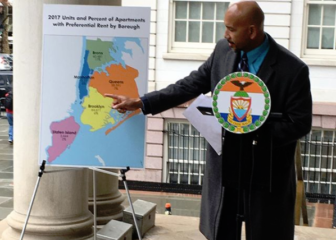
John DeSio
Bronx Borough President Ruben Diaz, Jr., discussing the role preferential rents play in the boroughs.
Bronx Borough President Ruben Diaz on Thursday proposed pairing new rent restrictions with a tax-break for property owners in a bid to address the New York City housing market’s Sword of Damocles: the threat of sudden, massive rent increases in regulated apartments where tenants right now enjoy preferential rents.
About 966,000 apartments in the city are rent stabilized, meaning landlords cannot typically raise the rent year to year more than the Rent Guidelines Board (RGB) allows in its annual decision. Last year, the RGB allowed rents on one-year leases to rise no more than 1.5 percent.
While property owners can boost rents on rent-stabilized units in other ways—by claiming costs associated with capital improvements, or qualifying for a bonus when an apartment changes hands—the RGB level is generally the hike a landlord can legally impose on the same tenant absent some capital work.
Unless, that is, the landlord—or, more to the point, the real-estate market—has given tenants a break in the past.
In some areas of the city and for many years, legal rents authorized by RGB increases were higher than the rental market would pay. So landlords offered discounts, called preferential rents. And that was good for those renters who got them, in the short term.
The problem for tenants and housing advocates, who consider rent-stabilized units a bulwark of affordability in the city, is that under existing law landlords can raise the rent to the legal rent whenever they want. In other words, all the foregone increases of the past can be implemented at once. If deep discounts were offered in years gone by, that could mean a whopping one-time increase in rent—something far higher than 1.5 percent.
According to the report released by Diaz, some 260,378 apartments in the city now have preferential rents. That’s 29 percent of all rent-stabilized apartments, and 7 percent of apartments overall. An Independent Budget Office analysis found that the average gap between the rent that was being charged and the rent that could be charged was $286 in 2008, but a much higher $444 in 2015.
That rent gap is highest in Manhattan ($800) but preferential rent is a bigger deal in the Bronx, where 11 percent of apartments feature one. Some neighborhoods are especially dense with vulnerable apartments, like Two Bridges in Manhattan, Bay Ridge in Brooklyn and the Ground Concourse corridor in the Bronx.
“New York State must reform its rent laws, and that includes strengthening tenant protections and closing the preferential rent loophole,” said Diaz in a statement accompanying the report.
Diaz doesn’t propose ending preferential rents per se. He supports a bill that would prevent landlords from jumping to the preferential rent during a tenancy; the jump could be made upon vacancy, however. That would create an incentive for landlords to push tenants out, so Diaz also calls for stronger tenant protections that would impose “increased civil penalties and compensatory damages” if that occurs.
Most interesting, and novel according to Frank Ricci, the head of government affairs at the property owners’ trade group, the Rent Stabilization Association, is Diaz’s tax proposal.
“Landlords in New York City should be given a property-tax break for the difference between the preferential rent and the legal registered rent in a given rent-stabilized apartment as part of this legislative proposal,” the beep’s proposal reads. “Many landlords could be categorized as small businesses, and should not lose potential income without some recompense, in this case coming in the form of tax credits. Landlords would be less likely to challenge the new law in the courts if they were being compensated for the potential loss of rental revenue in other ways.”
Ricci, who disputes the notion that preferential rent is a loophole (“It was a negotiated law” that benefited tenants, he says) or that any additional anti-harassment laws are needed, characterized the proposal as “interesting.”
“As always the devil is in the details and how workable it is,” he adds.
Diaz says the property-tax break will not be a net cost to the city because, by salvaging preferential units, his policy will save the city money on homeless shelters and the other costs generated by displacement. Landlords have long complained, with some justification, that the city’s property tax system unfairly burdens multiunit buildings, and that the RGB has failed to account for the increases in property taxes and other fees that landlords face. The property tax system could see reform this year.
Tenant advocates were skeptical of the tax element of Diaz’s plan.
“I wholeheartedly agree With making the preferential rent the legal rent for the duration of a tenancy. However, landlords should not be compensated for ignoring New York City Rent Guidelines Board’s decisions each year,” said Delsenia Glover, Director of Tenants & Neighbors. “Public money should not be used to reimburse landlords for rent hikes that are unjustified in the first place. It is fiscally irresponsible and further undermines the rent regulation framework” she added.

Adi Talwar
Natasha Creese relaxing with family and friends after a Sunday lunch in early 2015. She had recently faced a 112 percent rent hike.









One thought on “Diaz Suggests Landlord Tax Break in Exchange for New Rent Curbs”
Pingback: BP Calls for Subsidy to Offset Rent Hikes - This Is The Bronx